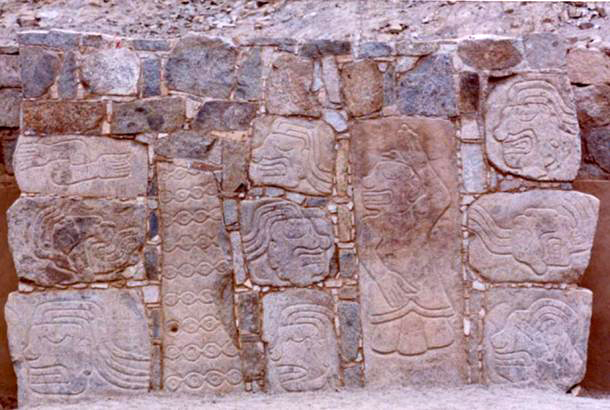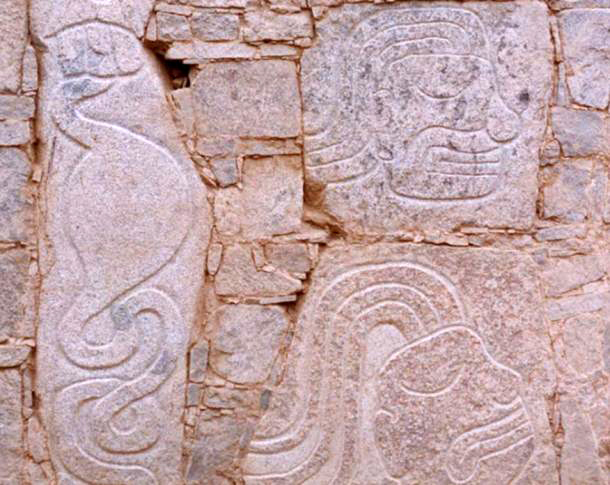I recently said: ‘Mesoamerica’s Amerindians from the Olmecs to the Aztecs (2,500 b.c.e. to 1521 c.e.) were true bastards: a culture of serial killers even of their own children—see the middle of my book Day of Wrath’. But further south, in Peru, the situation was the same and even in cultures at least as old as the Mesoamerican. The following article by Kerry Sullivan, ‘The Gruesome Sacrifice Carvings of Cerro Sechín: A 3,600-Year-Old Ceremonial Centre of Peru’ appeared last month. I reproduce it here so that the visitor may read it without the annoying ads in the original source:
______ 卐 ______
In 1600 B.C., there was no Internet, no television, and no printing press—how then could someone spread a message? For the ancient peoples of northern Peru, the answer was to carve reliefs into stone. Today, experts are not certain what message these ancient artists were trying to transmit at Cerro Sechín, however, the power of the images still resonates. Over 300 images at the site graphically depict (and even dramatise) human sacrifices and the gruesomeness of war. The scenes display a crushing victory by the warrior-priests over unknown enemies, many of whom are only represented as dismembered limbs.
There are several theories as to what the bas-relief images depict. Some say it is evidence an ancient study of anatomy, others say it is the depiction of a mythical battle among the gods. Taken together, it looks like the images show a procession of warriors making their way through the dismembered remains of ordinary people. This has led some people to believe the scene shows a historic battle while others think it depicts a crushed peasant uprising. In any event, one party decidedly defeated the other and the winners unleashed their vengeance on the losers without compassion, possibly part of a gruesome post-victory sacrificial ritual.
Monoliths at Cerro Sechín depicting warriors
and prisoners, the latter are dismembered.
The level of violence is shocking. There are severed heads, arms, and legs; eyeballs taken from a skull and skewered; bleeding corpses; bones bleaching in the sun. What is striking is the high-degree of anatomical accuracy of the body parts, especially the internal organs such as the stomach, kidneys, oesophagus, and intestines. Perhaps this level of insight was gained through scientific dissection but there can be little doubt that whoever the artists were, they had a great familiarity with dismembered bodies. They may have even had the pieces in front of them to look at while they carved.
The carving on the left depicts a stomach and intestines.
Cerro Sechín is situated on a granite hill in the Casma Valley, roughly 168 miles (270 km) north of Peru’s capital city, Lima. The carvings of Cerro Sechín are just one part of the larger Sechín Complex, which covers some 300 to 400 acres (120 to 160 hectares) and includes the Sechín Alto and the Sechín Bajo. The Sechín Alto is a large building complex that served as a temple. It is the largest pre-Columbian monument in Peru. The Sechín Bajo is a large circular plaza that may be the oldest portion of the Sechín Complex. Experts believe that the area served as a gathering point for social and religious purposes.
The archaeological site was first discovered in 1937 by Julio C. Tello, a renowned Peruvian archaeologist. The complex seems to have served as a public monument and ceremonial centre. The Sechín river cuts through the complex and there is evidence of small-scale irrigation agriculture in the area. Its proximity to the ocean (the Pacific is 13km away) suggests that the inhabitants of the Sechín Complex had easy access to the coastal cities and marine goods.
Cerro Sechín stretches over 164,042 feet (50,000 meters) within the Sechín Complex. It is a quadrangular three-tiered stepped platform flanked on each side by two smaller buildings. The monument was constructed in several stages using conical adobes, or large sun-dried bricks with broad circular bases and tapered points, which were then set into clay mortar and plastered over to form wall surfaces.
Little is known about the architects of the Sechín Complex. They were most likely a high-developed society. The north-western coast of Peru was occupied by the Casma/ Sechín people from approximately 2000 B.C. to 900 B.C., meaning that they predated the great Incan society of Peru. Contrary to formerly held beliefs about pre-Columbian societies, the evidence at Sechín suggests that American civilisations were advanced and booming at the same time as Mesopotamia, half a world away. The cities had complex political entanglements and refined religious practices. There was a vibrant trade between the coasts and the interior. Technologies such as woven textiles and irrigation were mastered and commercialised. The population was largely sedentary and under the control of political/religious/cultural elites.
Warfare and raiding between cities were most likely common in those days. The violence of the age lends support to the anatomical familiarity of the artisans as well as to the need to appease vengeful gods with human sacrifices. The Casma/Sechín culture declined around the same time that other Peruvian ceremonial centres declined, suggesting a possible common cause such as a drought or famine.

